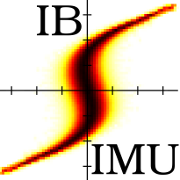Power density plots on solid surfaces
For making plots of power density on solid surfaces, I have used the followng helper class:
struct Power {
Transformation t;
std::vector<double> xdata;
std::vector<double> ydata;
std::vector<double> wdata;
void add( const Particle3D &pp ) {
Vec3D x = pp.location();
Vec3D vel = pp.velocity();
x = t.transform_point( x );
xdata.push_back( x[0] );
ydata.push_back( x[1] );
double V = 0.5*pp.m()*vel.ssqr()/pp.q();
wdata.push_back( pp.IQ()*V );
}
void plot( const std::string &filename ) {
// Make histogram
Histogram2D h( 51, 51, xdata, ydata, wdata );
h.convert_to_density();
// Output data
ofstream ostr( filename.c_str() );
for( size_t j = 0; j < h.m(); j++ ) {
for( size_t i = 0; i < h.n(); i++ ) {
ostr << setw(12) << h.icoord(i) << " "
<< setw(12) << h.jcoord(j) << " "
<< setw(12) << h(i,j) << "\n";
}
ostr << "\n";
}
ostr.close();
}
};
The class gathers energy data from collided particles and transforms the coordinates from 3D collision point into a 2D plot plane. So first you need to make on object of the type Power and define the translation:
Power power; power.t.translate( Vec3D(0.008486,0,-0.053258) ); power.t.rotate_y( atan(55.71/153.05) );
You should go through the particle collision points and select the ones which are interesting feeding those to power:
// Go through particle end locations
for( size_t i = 0; i < pdb.size(); i++ ) {
// Particle location
Particle3D &pp = pdb.particle( i );
// Not interesting location
if( pp[PARTICLE_Z] < 37.0e-3 ||
pp[PARTICLE_Z] > 60.0e-3 ||
pp[PARTICLE_X] > 0.0e-3 )
continue;
power.add( pp );
}
Then as a last thing, plot out the data to an ASCII file:
power.plot( "power.txt" );
